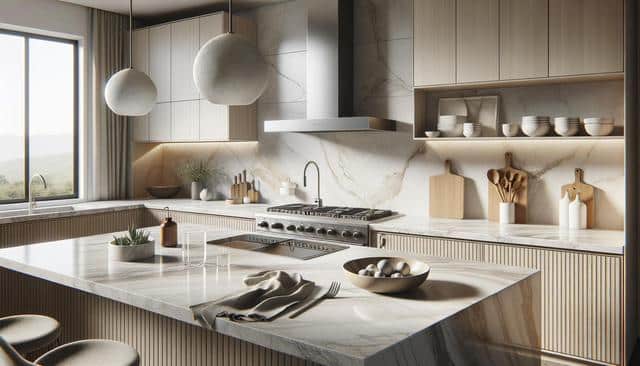
Discover The Bold Alternative To Quartz Countertops
What Is Sintered Stone and How Is It Made?
Sintered stone is a durable material created through a process that mimics natural stone formation. It involves using heat and pressure to compact raw minerals into a dense, non-porous surface. Unlike quartz, which often contains resins, sintered stone is composed purely of natural components such as clay, feldspar, silica, and mineral oxides. These ingredients are subjected to intense heat—often exceeding 2,000°F—and extreme pressure, resulting in a surface that is both hard-wearing and visually appealing. The advanced manufacturing process ensures consistency in color and pattern, making it a popular choice for modern interior design.
Why Homeowners Are Choosing Sintered Stone Countertops
Homeowners looking for a surface that combines style and substance are increasingly turning to sintered stone countertops. These surfaces offer several advantages that make them a compelling alternative to quartz:
- Exceptional durability: Resistant to scratching, heat, and UV exposure.
- Low maintenance: Non-porous surface prevents staining, so no sealing is required.
- Design versatility: Available in a wide range of colors, textures, and finishes.
- Eco-conscious production: Manufactured using natural materials and without harmful resins.
These benefits make sintered stone an ideal choice for both kitchens and bathrooms, especially for those seeking a sleek and contemporary look. As awareness grows, more people are consulting experienced sintered stone countertops installers to bring this cutting-edge material into their homes.
Comparing Sintered Stone to Quartz Countertops
While both sintered stone and quartz offer attractive and durable surfaces, there are some key distinctions that set them apart. Quartz countertops are made using a mix of natural quartz crystals and synthetic resins, which can limit their heat resistance. In contrast, sintered stone is free from resins and offers better performance in high-temperature environments. Additionally, sintered stone is often more resistant to UV rays, making it suitable for outdoor use, whereas quartz may discolor over time when exposed to sunlight.
In terms of aesthetics, sintered stone provides a broader scope for design replication, including the appearance of marble, concrete, or even metal. The technology behind its production allows for sharper details and a more tactile surface. This flexibility is one reason why skilled sintered stone countertops installers are seeing rising demand for both residential and commercial projects.
Installation Considerations and Choosing the Right Installer
Installing sintered stone countertops requires a high level of precision and expertise. The material is incredibly dense, which makes it more challenging to cut and handle compared to conventional stone surfaces. For this reason, it’s essential to work with professional sintered stone countertops installers who have the proper equipment and experience. An experienced installer will ensure accurate measurements, clean cuts, and secure fitting, which are critical to the material’s performance and appearance.
When choosing an installer, consider the following:
- Check for certifications or specialized training in sintered stone handling.
- Request a portfolio or case studies of past installations.
- Ask for customer reviews or testimonials.
- Ensure they use the right tools and techniques for this specific material.
Partnering with a qualified professional ensures that your investment in sintered stone delivers lasting value and visual impact.
Applications Beyond the Kitchen
Sintered stone is not limited to kitchen countertops; its versatile and robust nature makes it suitable for a wide range of applications. From bathroom vanities to fireplace surrounds, and even outdoor kitchens, this material holds up well in different environments. Its resistance to extreme temperatures, moisture, and UV exposure means it can be used in areas where other surfaces might fail.
Popular uses for sintered stone beyond countertops include:
- Wall cladding for a seamless, modern aesthetic
- Flooring in high-traffic areas
- Outdoor dining and cooking surfaces
- Integrated sinks and shower walls
With the help of experienced sintered stone countertops installers, homeowners and designers can explore creative ways to incorporate this material into various parts of a home or commercial space, adding both function and flair.
Conclusion: A Contemporary Surface Worth Considering
Sintered stone countertops offer a compelling alternative to quartz, blending durability, sustainability, and design flexibility. As more homeowners seek materials that align with modern aesthetics and practical needs, sintered stone is increasingly becoming a go-to option. Whether you’re renovating a kitchen, upgrading a bathroom, or designing an outdoor space, this surface delivers impressive performance across the board. To ensure the best results, always work with professional sintered stone countertops installers who can bring your vision to life with precision and care.